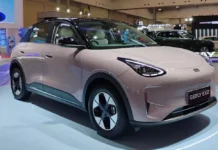Hyundai showcases the Kona Electric at the Indonesia International Motor Show (IIMS) in February 2024, but it’s not until the Gaikindo Indonesia International Auto Show (GIIAS) later this year that the brand officially announces its pricing and availability for the Indonesian market.
Assembled locally, the Hyundai Kona Electric comes in five variants: Style, Prime Standard Range, Prime Long Range, Signature Standard Range, and Signature Long Range. Pricing for this South Korean electric vehicle starts at 499 million Rupiah and goes up to 590 million Rupiah (approximately 778 to 920 million VND).

The all-electric version of the Hyundai Kona is assembled and sold in Southeast Asia.
The Hyundai Kona Electric, being a fully electric vehicle, doesn’t come cheap in Indonesia. However, compared to its sibling, the Hyundai Ioniq 5, which is priced between 713 and 902 million Rupiah, the Kona Electric is significantly more affordable.
The Kona Electric is Hyundai’s third electric vehicle offering in Indonesia, following the Ioniq 5 and Ioniq 6. But it stands out as the first Hyundai electric car to feature batteries made in Indonesia. This is a result of Hyundai’s joint venture with LG Energy Solutions for local battery production.
The new-generation Hyundai Kona Electric made its global debut in South Korea back in December 2022. It is one of three members of the new Hyundai Kona family, which also includes gasoline and hybrid variants.
With dimensions of 4,355 mm in length, 1,825 mm in width, and 1,550 mm in height, the new Kona Electric is similar in size to the VinFast VF6. However, its wheelbase is 70 mm shorter, at 2,660 mm.

The Hyundai Kona Electric competes in the same segment as the VinFast VF6.
Exterior differences between the electric and gasoline/hybrid versions are subtle, including a closed grille with an integrated charging port, unique front and rear bumpers, and distinct alloy wheels. Additionally, the electric model features pixelated light strips at the front and rear.

The Hyundai Kona Electric sports pixelated light strips at the rear.
Standard equipment on the B-segment electric SUV includes a battery temperature control system, LED daytime running lights, 17-inch alloy wheels, a fully digital 12.3-inch instrument cluster, a matching 12.3-inch central touchscreen, remote start, Bluelink connected services, and dual-zone automatic climate control, among others. Upgrading to the top-spec variant adds an eight-speaker Bose sound system, wireless phone charging, a panoramic sunroof, a power tailgate, V2L functionality, and 19-inch alloy wheels.

The 19-inch alloy wheels of the Hyundai Kona Electric.

Inside the Hyundai Kona Electric.

The rear seats of the Kona Electric offer ample space.
All variants come standard with six airbags, hill-start assist, electronic parking brake, and auto hold. The range-topping variant benefits from advanced driver-assistance systems (ADAS), including forward-collision avoidance assist, lane-keeping assist, driver attention warning, and smart cruise control. Additionally, it gets blind-spot collision avoidance assist, rear cross-traffic collision avoidance assist, a 360-degree camera, and safe exit warning.
Regardless of the variant, the Hyundai Kona Electric is powered by a single electric motor mounted on the front axle. The Standard Range models produce 154 horsepower, while the Long Range versions generate 214 horsepower. Peak torque stands at 255 Nm for all variants.
The Standard Range models are fitted with a 48.9 kWh lithium-ion battery, offering an estimated range of 448 kilometers on the NEDC cycle. On the other hand, the Long Range variants benefit from a larger 66 kWh battery, increasing the range to 549 kilometers (Signature) or 602 kilometers (Prime), respectively.

The Hyundai Kona Electric boasts a maximum range of 602 kilometers.
It remains to be seen whether the Hyundai Kona Electric will be offered in other Southeast Asian markets, such as Vietnam, following its launch in Indonesia. Currently, Hyundai Vietnam offers the Ioniq 5 electric vehicle, with prices starting from 1.3 to 1.45 billion VND.












































